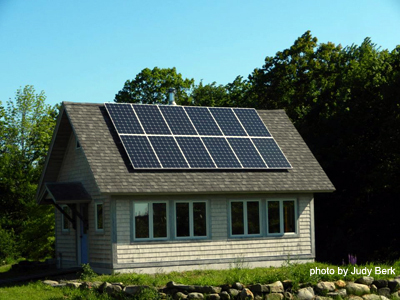
Solar panels in Northport, Maine.
So the Public Utilities Commission (PUC) did a study that concluded the “value of solar” is 33.7 cents/kwh. (The study was done in response to legislation last year that NRCM developed and led the passage of.) What in the world does that mean? Is that what solar is worth? What it costs? How does that compare to anything else that the average person understands? Who benefits from that 33.7 cents?
Let’s take a real world example: a rooftop home solar installation that is 5 kilowatts (KW), or enough to provide most of an average homeowner’s electricity use.
Over 25 years, that system will produce about 165,000 kilowatt-hours (the system probably lasts for 30 years, but the PUC did the math for 25 years). All of it is produced during the day time (shocking!), which corresponds well with the highest demand for power on the electric grid. And it produces power for the longest amount of time during the summer (another shocker: days are long during the summer!) which is when we really have heavy demand. Many of the costs we pay as electricity consumers are determined not just how many kilowatt-hours we use, but by the pattern of high demand on the transmission grid and on power plants.
When demand is very high, that solar power from your roof is also special because it’s produced where you are going to use it. So instead of adding to demand on the grid, you are subtracting from it.
A big part of the value of solar study was quantifying the benefits of the pattern of kilowatt-hours produced by the unique properties of solar, especially “distributed” solar.
So, over 25 years, that home solar installation will yield the following benefits:
- $13,300 worth of electricity as a commodity
This is great, but this value doesn’t count any of the benefit that would be shared by anyone else. What about the benefits to other ratepayers because of what that solar does for the grid and the reduced need to run expensive power plants? That’s worth:
- $26,100 of reduced costs for other electricity customers
And it doesn’t stop there. That solar reduces a considerable amount of air and climate pollution over 25 years. Quantifying this is tricky, but reduced respiratory illness and less climate change is worth something, so here’s a conservative estimate from economists and other experts, according to the PUC:
- $15,750 of reduced pollution benefits.
So our home solar installation benefits everyone else to the tune of:
- $42,000 over 25 years (plus the power has a commodity value of $13,300 for a total of $55,200).
That’s $42,000 worth of public benefits for every home solar installation—or, if we don’t build that system, it’s $42,000 worth of costs that we pay, in more expensive power plants, unnecessarily electric grid upgrades, higher electric rates, and harmful pollution.
Net-metering goes a little way to compensating you for the value of your solar. Over 25 years, our solar homeowner might be given some $26,000 in credits on their bill. (This and all the other numbers here are in “present value,” meaning, future savings are “discounted” into today’s dollars.) So CMP is paying our solar homeowner $26,000 for something that benefits other ratepayers and the public by $42,000. Seems like we’re missing something…
We’re missing some policies to treat solar fairly and that do more to grow the solar market and increase access to solar for more homes and businesses. We’re missing some solar policies that will actually achieve more of these benefits for the public.
By the way, how much do you have to pay upfront to install a 5-KW solar system? About $12,250 after tax credits. It’s a good deal, and it would be a much better deal if Maine was doing more to reduce barriers that currently are keeping the lid on solar in Maine compared to all the other states around us.











My principal question re this study is whether anyone,like Sen. Woodsome chair of the energy committee has even reacted to the study publically.Or,since they probably didn’t want the study first of all,they like it even less since it gave them a result they will just ignore.And what is their reaction when one points out that natural gas is at least half as crappy as coal?
Great questions. The value of solar study has definitely had a positive impact on the dialogue about solar at the State House. For the first time we have had third-party validated numbers about the benefits of solar. So often opposition to renewable energy has been able to focus only on the costs because they are easier to add up. Unfortunately that has continued to a certain extent, as utilities like Central Maine Power continue to testify and comment about the cost of solar or net-metering without giving credence to benefits. But we’ve been able to push back and there has been some momentum toward a conversation about HOW to better capture the value of solar.
The only way to get anywhere close to a fair etismate is to actually call up a solar installer in your area, and get a free quote. The price depends vastly on your energy usage, and your location. Two houses can be neighbors, and one can use 20 times as much electricity.Solar hot water costs $4-6k, after which you may get some rebates or credits.Solar electricity costs $6k and up, after which you may get rebates or credits. A typical system, if there is such a thing, is several times that size, and it is not unheard of to have a system 20 times that large.
And with solar costs coming down rapidly, if you got a solar quote a year or two ago, you should consider looking at solar again!